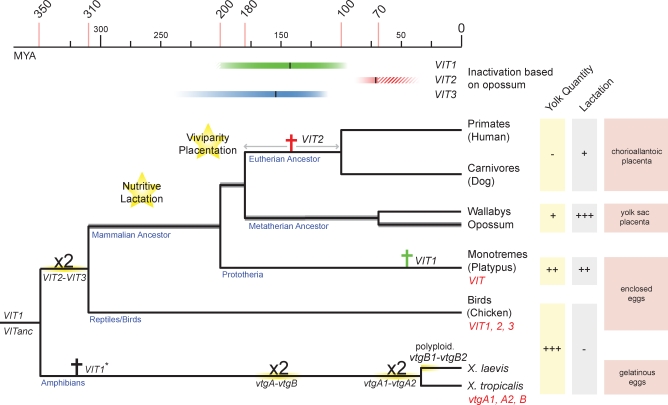File:VIT Gene Evolution.jpg
VIT_Gene_Evolution.jpg (668 × 405 pixels, file size: 76 KB, MIME type: image/jpeg)
Vitellogenin (VIT) Gene Evolution in Tetrapods
The topology and divergence times of the tree are based on previous studies [19,24,25,41].
Latin crosses indicate VIT inactivation events in eutherians and monotremes. Inactivation estimates (including approximated 95% prediction intervals) based on opossum VIT sequences are indicated by colored bars at the top (see also Figure 3). Duplications (“x2”) are indicated. VITanc is the likely ancestor of both the amphibian vtgA1/vtgA2 and VIT2/VIT3 genes in birds. Functional VIT genes in extant species are indicated in red.
The inactivation time of VIT1* on the amphibian branch could not be estimated because of its absence in Xenopus tropicalis.
Original File name: Pbio.0060063.g001.jpg
Paper Abstract: "Embryonic development in nonmammalian vertebrates depends entirely on nutritional reserves that are predominantly derived from vitellogenin proteins and stored in egg yolk. Mammals have evolved new resources, such as lactation and placentation, to nourish their developing and early offspring. However, the evolutionary timing and molecular events associated with this major phenotypic transition are not known. By means of sensitive comparative genomics analyses and evolutionary simulations, we here show that the three ancestral vitellogenin-encoding genes were progressively lost during mammalian evolution (until around 30–70 million years ago, Mya) in all but the egg-laying monotremes, which have retained a functional vitellogenin gene. Our analyses also provide evidence that the major milk resource genes, caseins, which have similar functional properties as vitellogenins, appeared in the common mammalian ancestor ~200–310 Mya. Together, our data are compatible with the hypothesis that the emergence of lactation in the common mammalian ancestor and the development of placentation in eutherian and marsupial mammals allowed for the gradual loss of yolk-dependent nourishment during mammalian evolution."
Reference
<pubmed>18351802</pubmed>| PMCID: PMC2267819
PLoS Biol. 2008 March; 6(3): e63. Published online 2008 March 18. doi: 10.1371/journal.pbio.0060063.
Copyright : © 2008 Brawand et al. This is an open-access article distributed under the terms of the Creative Commons Attribution License, which permits unrestricted use, distribution, and reproduction in any medium, provided the original author and source are credited.
File history
Click on a date/time to view the file as it appeared at that time.
| Date/Time | Thumbnail | Dimensions | User | Comment | |
|---|---|---|---|---|---|
| current | 09:14, 16 August 2009 |  | 668 × 405 (76 KB) | S8600021 (talk | contribs) | VIT Gene Evolution in Tetrapods The topology and divergence times of the tree are based on previous studies [19,24,25,41]. Latin crosses indicate VIT inactivation events in eutherians and monotremes. Inactivation estimates (including approximated 95% pre |
You cannot overwrite this file.
File usage
There are no pages that use this file.
